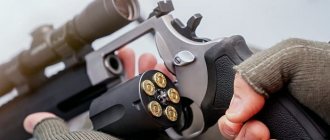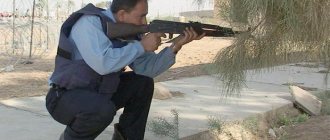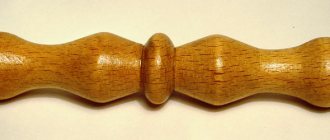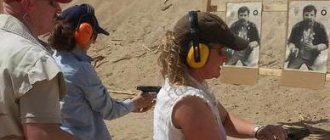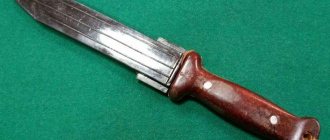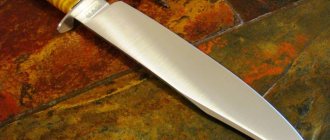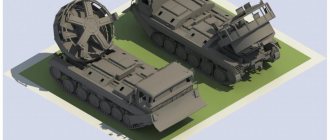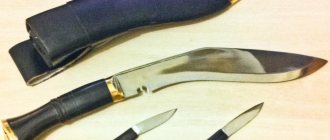It is believed that most types of martial arts came to us from Southeast Asia. We know that there are several dozen schools that pass on the secret of the teachings from generation to generation. Such teachings are more a philosophy of life than a martial art. I have always been amazed by the ability of great masters to arm themselves with improvised objects. We see how in films the main character seems to be juggling with sticks, swords, and knives that come to hand. However, the simplest weapons actually often appeared by chance, from a household item, agricultural tool, or piece of furniture.
A popular weapon today, originally from the island of Okinawa, is Tonfa (tui-fa, tongwa, ton-fa). It is believed that it was not invented as a weapon. This was originally the handle of a small rice mill. In martial arts it is often used in pairs. Democratizers (as police batons were jokingly called) are a practical copy of a tonfa, only the baton that was originally discussed was made of wood.
Time had no power over the tonfa, and over the five hundred years of its existence, it remained virtually unchanged in appearance. Despite the presence of different materials, the weapon itself, as a crutch, remains to be represented.
Tonfa is a weapon with impact and crushing action, consisting of a stick and a perpendicular handle.
History of origin
Tonfa boasts a rather unique history, which is very similar to the history of the creation of the nunchuk. At first, no one even suspected that an ordinary agricultural tool would be in any way involved in martial arts. In the Middle Ages, peasants often had to defend themselves. The most vulnerable class took into service everything that came to hand. Among these things was a mill handle - a tonfa. Later, a whole teaching of martial art was born - kabudo, in which such a simple hand acted as a weapon for self-defense.
After a short time, the popularity of tonfa spread beyond the island of Okinawa. Very soon, terms such as karate, nunchaku, kabudo and tonfa became known throughout Japan. The simplicity of the weapon is deceptive. Despite its trivial design, tui-fa can serve as a universal weapon for offensive and defensive purposes.
The appearance of the tonfa as a weapon dates back to the fifteenth century. There were no strict drawings, as well as dimensions for making the handle. The dimensions were dictated by the size of the fighter's hand. Some historians believe that the stick originally appeared in China, and only then on the island of Okinawa. Its prototype was not the mill handle, but Li Tieguai’s crutch or “lame Li’s crutch.” Law enforcement officers in Japan carried samurai swords.
In Russia, police were also armed with sabers, and police batons appeared in the police only in 1881. In the mid-20th century, Americans patented the Prosecutor PR-24 rubber baton, which was a copy of tonfa, only it was made of rubber and epoxy resin with the addition of aluminum polycarbonates. Lon Anderson himself, the man who patented the police baton, claimed that it had no resemblance to the Japanese tonfa. It was just a broken chair leg with a crossbar. But since the 70s of the 20th century saw the peak of popularity of martial arts and weapons from South Asia, there is no doubt where the roots come from.
The Prosecutor PR-24 baton was manufactured to strict standards. They had a diameter of 3 cm and a length of 60 cm. Its weight varied from 600 to 800 g, since the weapon was made of various materials. The batons entered service with the American army and police in 1974.
The police were enthusiastic about the new type of weapon, because it was possible to control the situation on the streets without using firearms. Skillful actions with the tonfa made it possible not only to beat the criminal, but also to capture him, apply a painful hold, or effectively defend himself.
Summarizing the above, it can be argued that a weapon that is unsightly at first glance has hidden capabilities. A new round of popularity for tonfa came from America. Currently, Russian police are equipped with similar weapons. Our versions – PR-90 and PR-90-M allow you to install an additional aerosol can “Cheryomukha-10”.
What is tonfa
Tonfa is a well-forgotten and newly revived old Japanese edged weapon, which became the prototype of a baton (we call it a democratizer). In fact, it is one of the oldest and quite effective types of edged weapons, which have become widespread in the countries of Southeast Asia. It came to European countries from Okinawa.
The essence of tactics and techniques for fighting with tonfa has remained unchanged for many centuries. It is based on handwritten ancient Japanese treatises. In the 70s of the last century, a new method of using tonfa was specially developed for American security forces. This unique baton turned out to be an indispensable attribute not only of police officers, but also of other representatives of law enforcement agencies.
Weapon handling technique
Tonfa allows a fighter to demonstrate a whole series of strikes, blocks and grabs during a fight. The usual grip is made by the transverse handle in such a way that the long end of the tonfa runs along the forearm, and its short end comes out from behind the fist and protrudes forward. With the long end of the stick, a fighter can block almost any enemy blow. The stick protects the forearm even from blows from cold weapons. The same forearm, reinforced with a baton, is used to deliver push and swing blows.
Swing blows can also be applied with the short part of the tonfa, and they will be no less effective. In various martial arts, the baton is used in pairs. They are rotated about an axis passing through the handle, providing a series of whipping or poking blows. The baton technique was developed specifically for police officers. Most of the theoretical material contained ideas about the areas of the human body that need to be influenced. For example, blows to the limbs immobilize a suspect without injuring him. And areas such as the chest and back are central. They can be influenced only in the most urgent cases.
Today there are several modern teachings that discuss in detail the technique of using tonfa. Moreover, these teachings can differ radically from each other. So, we can single out Japanese technology; it is closer to what was studied in Okinawa. In Japanese technique, kata are practiced and the fighter, moving up the ladder of skill, receives colored belts. European schools focus on the practical component of weapons.
Tonfa
The baton is perhaps the most famous weapon in the law enforcement arsenal. In England, wooden batons began to be used in the mid-19th century. In Russia, “lower police ranks” began to be equipped with such “clubs” at the end of the same century instead of sabers. In Japan, the police began to actively use batons after the First World War, along with new methods of hand-to-hand combat, developed specifically for internal organs (before that they preferred to carry swords, which, however, depending on various conditions, could not always be used successfully). The modern police baton, patented in the USA, rubber and with a cross handle, familiar to many (particularly from American films), also originates in Japan, only it was not invented by the military, but, as usual, by peasants.
Types of English police batons. (Pinterest)
The origin of this weapon is again controversial: according to one version, the birthplace of the tonfa is not Japan at all, but China, where the crutch became the prototype. According to the second, most common, tonfa was invented, like other objects of Okinawan kobudo, by peasants after the ban on carrying and owning weapons in 1609. Originally it was a lever from a hand mill, with the help of which various grains were ground into flour. The design of the gun was simple: a wooden beam with a transverse handle closer to the upper end for convenient rotation of the millstone. How and who exactly came up with the idea to use the tool in battle is unclear. But it can be assumed that this “lever” was used for protection. In this sense, with the help of tonfa it was possible to defend against almost any kobudo weapon, however, when studying this weapon, special attention is paid to working with a pole (or a long wooden stick - bo). Actually, the technique of using tonfa (tonfa-jutsu) is precisely based on blocking blows and counterattacks. Moreover, as a rule, dual weapons were used: that is, one could block an enemy attack with one hand, and strike with the other. Moreover, in fact, almost all weapons consist of impact surfaces: a poke strike could be delivered with both ends (upper and lower); the knob of the handle could be used to attack the ear, chin, and also the head. Even the surface covering the forearm could become a striker - if the weapon was held by the short end, the tonfa was used as a regular club.
Tonfa. (Pinterest)
There was no uniform standard for the manufacture of these weapons. The tonfa was selected and made according to the person's hand. The most famous and considered classic version is a wooden tonfa with a rectangular cross-section at the handle. Over several centuries, weapons have not undergone major changes: the material has changed (metal, rubber), but the form has not changed, which was only gaining popularity. Nowadays, tonfa is largely associated not so much with kobudo weapons or Okinawan karate, but with the “special equipment” of police officers. Indeed, in the late 1960s and early 1970s, the police baton was transformed and took the form of the Okinawan tonfa. There is an assumption that for the first time the police in Europe used such an updated baton when suppressing student riots in Paris in the late 1960s.
Baton. (Pinterest)
In 1971, American Lon Anderson patented a new police baton - a “stick with a side handle.” Despite the fact that it differed from the Okinawan tonfa perhaps only in its more streamlined shape, the author himself claimed that the invention was inspired by memories from childhood, namely “a broken leg from a chair with a crossbar.” At the same time, we must not forget that it was at this time that martial arts and oriental weapons were being popularized in America, so it is not surprising that some of the traditional attributes of kobudo were adopted by law enforcement agencies. The police tonfa was brought to a single standard and was called “Prosecutor PR-24” (protect and restrain - “protection and deterrence”, where 24 is the length in inches). Now, a standard tonfa is about 60 cm in length, with a diameter of 3 cm and weighing 600-800 grams. The weight could depend on the materials: it could be polycarbonate, epoxy resin-based materials or aluminum. The tonfa is usually made entirely, but batons are also known where the handle can be attached if necessary. The police fell in love with the tonfa not only as a defensive weapon that reliably protects the forearm, but also as a tool with which one can easily carry out a seizure or capture of a criminal. Thus, thanks to the side handle, it is easy to perform a painful hold during detention or to knock the opponent down. For special forces, a whole classification of zones has been developed that can be most effectively hit with tonfa: for example, blows to the arms and legs cause minimal and temporary damage, but mainly incapacitate the enemy when detained, but the face, chest and back should be attacked last. due to increased risk of injury and only in emergency cases.
Doubletonfa. (Pinterest)
Further development of weapons led to the appearance in 1989 of a police stick with two handles located at opposite ends - the “doubletonf”. Officially, this invention was named AKD-48, where the number “48” is a reference to the previous version of the PR-24, which seems to indicate greater efficiency. However, if the police tonfa was still largely focused on striking techniques, then the “doubletonfa” was focused on protection from blows, as well as a greater use of painful techniques and throws when detaining an offender. But if you do not belong to law enforcement agencies and do not intend to detain criminals, then the tonfa is a prohibited type of weapon, the carrying and circulation of which falls under the Federal Law “On Weapons” as impact-crushing weapons.
Grabs and strikes
If the baton is conditionally divided into three parts, then it will consist of a transverse handle, a longitudinal handle and an impact part. The transverse handle divides the main stick into two parts. The larger one is called the shock part.
There are four basic grips for the tonfa:
- Grab the longitudinal handle. This is the classic holding of a stick in the hand.
- Grab the striking part.
- Grab the cross handle with the longitudinal handle forward.
- Grab the cross handle with the striking part forward.
When holding a baton in a classic manner, a transverse handle is completely unnecessary. This grip is used for sticks that have neither a guard nor a crossbar. The blows are thrown backhand, just as we all chopped nettles with sticks when we were children. To set a block, the grip does not change, that is, the baton in the hand during the block remains in the same position as when striking. Exercises with this grip are reminiscent of fencing.
The grip on the striking part is used very rarely. The fighter must avoid close contact, since it is almost impossible to block with such a grip. But blows delivered with the butt of the side handle can be very painful. Using such a grip, you can hook a running person onto protruding elements of clothing (a strap, a collar). Don't forget about the industrial effect of the baton. By gripping the striking part, you can hammer a nail, split a body, or knock out glass.
The standard grip is considered to be a direct grip on the crossbar, when the striking part of the tonfa is like an extension of the hand, and the longitudinal handle looks forward and protrudes from behind the wrist. With this grip you can perform the following techniques:
- Place a block;
- Make a poke with a crutch (for this you need to apply a regular blow with your hand);
- Strike with the side of your palm, reinforced with a stick.
The reverse side handle grip, with the striking part of the baton facing forward, is used to deliver poke blows over long distances. At the same time, the effectiveness of the swing blow is reduced.
The combat crutch has an average degree of lethality. If it is impossible to guarantee killing a person, then causing him serious harm is quite possible. The main injuries from the use of tonfa are considered to be knocked out teeth, abrasions, and broken limbs. In the Russian Federation, according to the law, tonfa refers to special equipment, but not to weapons. This means that its use is not prohibited, but is associated with a number of certain restrictions, that is, if a person uses a baton in battle, then this fact can be considered as the use of special equipment with the ensuing consequences. However, the use of uncertified batons and homemade products risks the fact that a person will be “taught” to use knives.
Tonfa is often used in martial arts training. It turns out that when practicing techniques, such muscle groups as the muscles of the forearm, biceps, oblique abdominal muscles, triceps, calf muscles, abs, trapezius muscles, and ankle are involved in a complex manner.
Despite the long passage of time since the release of the old, old (but so cute in their stupidity) American films about ninja, where the concepts of all Japanese budo (such as katanas, nuntyaku, ninjas, samurai and shurikens, etc.) were mixed into one viscous, monotonous substance, the expression “ninja with nunchucks” still sometimes takes on a meaningful image, as opposed to reasonable opinion, where the same expression is perceived only as a joke. However, nunchucks are a classic weapon of Japanese bujutsu and the ability to work with them distinguishes many BI masters, regardless of their “native” schools. about how to make nuntyaku and tonfa .
Both nuntyaku and tonfa are shock weapons that originated on the Japanese islands among peasants who were deprived of the opportunity to carry “real” weapons. Hence their rather unusual appearance: nuntyaku was used for threshing grain crops, and tonfa was just a handle from the millstones of a hand mill.
The main material for making nuntyaku and tonfa is wood. Choose hardwoods and avoid pine needles! For more information on choosing wood, see the article on bokken. For both training tonfa and nuntyaku, you will need bars at least four centimeters thick (minimum). Now a little more detail about each type of weapon.
- Nuntyaku.
- The length of the weapon is determined by the anatomical features of its future owner. Measure the distance from the bend of your elbow to the middle of your palm - this will give you the required length of the poles.
- Grind and sand the bars until they are (roughly) even cylinders. You can also make six- and octagonal sticks for nunchucks.
- Drill through holes for the rope one and a half to two centimeters from the end of the combat parts.
- The length of the rope should be such that you can freely tie the warheads to a distance slightly greater than the width of your palm. It is better if the rope is double.
- Thread the rope through the holes and secure with a knot so that it comes out exactly in the center of the end.
- Ready!
The most primitive nuntyaku were made (and are still being successfully made) by amateurs in the eighties and nineties of the last century from stool legs. Whether to follow their worthy example is everyone’s choice, but try not to blind yourself to strict regulations. If you’ve already come across a good stool, why not make a whole pair of stools out of it? Or if you are not a fan of ropes, but have a piece of a good strong chain, then it can easily replace the connecting cord. Flexibility is what distinguished the ninja in matters not only of hand-to-hand or armed combat, but also in solving pressing issues.
For example, another way to make training nunchucks is from rolls of paper. Everything is elementary - you fold the paper, wrap it with tape/isolate tape or apply glue - please. But it’s clearly not worth thinking about this as a real weapon.
- Tonfa
- Sizes are individual. Length of the bar = distance from the middle of the palm to the elbow + length of the palm + width of the palm with a small margin. Handle length = palm width + three finger widths + allowance for attaching to a block.
- The block must be sharpened and sanded. A cylindrical shape for tonfa is not necessary, as there are also rectangular options. The classic kobudo is rectangular in the area where the handle is attached, and cylindrical at the ends of the bar. Ideally, there should be a knot where the handle is installed (since the wood fibers will go around it and you will not have to unnecessarily weaken the tonfa with unnecessary cuts).
- Treat the handle so that it is comfortable to hold in your hand, with a thickening at the upper end (so that it does not slip out). Shape the bottom part into a square or hexagon.
- Drill and machine a hole in the block for installing the handle so that it has the shape of a rectangle or hexagon - so that the handle, processed in the same way, does not rotate.
- Fasten (or drive) the handle into the block, fill it with glue and drive in a couple of nails/wedges - this way the handle will fit tightly to the block.
- Varnishing and impregnation - optional.
In general, tonfa is often confused with a police baton , but our domestic baton has very little in common with the classic Japanese weapons. The rubber glides too poorly in the hand, and therefore practically the only purpose of the side handle of the Russian democratizer is to hold the main “percussion instrument” behind the belt.
Both nuntyaku and tonfa are edged weapons, don't forget that. Therefore, try to keep training weapons only in places where you practice (for example, in the gym). Any transportation of them before training should be carried out in cases.
Tonfa in the police
A rubber baton is the most recognizable attribute of a modern police officer, regardless of nationality. In England, police were armed with wooden batons in the 19th century. In Russia, police officers carried sabers, only the lower “class” used batons rather than sabers. In Japan, police officers acquired batons immediately after the First World War. Over time, it was the Japanese police who made adjustments and new techniques to the tonfa technique. Special training manuals were created for law enforcement officers. Until this time, the police were armed with swords. Needless to say, the policeman did not always have the right to use such a formidable weapon?
The Americans patented the rubber baton, which we often see in movies, using the same police officers as an example. But to be fair, there was nothing new in this design, since the stick, both in form and purpose, had long been known. Tonfa PR-73 in Russia is found not only among police officers. Since it is not officially considered a weapon, it is freely used by employees of private security companies (not to be confused with a telescopic baton).
We can say that at present the tonfa is of no interest to collectors of old types of weapons, since in a modern interpretation it is found in real life. Buying a baton is not difficult, but the average person is advised to make sure that the weapon has the necessary certificate.
Variations on the origin of tonfa
Many historians have proposed a wide variety of options for the origin of tonfa. According to one of them, officially accepted, tonfa was developed not by anyone, but by real Japanese ninjas who lived on the island of Okinawa. They decided to improve the baton, which was believed to be of Chinese or Indonesian origin, for their own needs.
The main version of the origin of the tonfa states that the handle of a millstone from a hand mill was placed at the base of this type of bladed weapon. These mills were used by peasants to grind grain crops. According to another version, the tonfa is a modification of the crutches of crippled commoners of the 15th century. At that time, the number of such people was quite high due to the lack of medical care. Be that as it may, tonfa was considered a weapon of commoners.
Since the unification of the Ryukyu Archipelago in 1429, Okinawa has been the central island of the new entity. In connection with the local van law adopted in all provinces, commoners were prohibited from carrying and using weapons. Due to the fact that the masses were completely poor, there was a complete lack of funds for the purchase of professional weapons. However, as a result of this, commoners were busy creating their own inventions. And with what they got, they had to defend their meager belongings from the emperor’s tax collectors.
On the island of Okinawa they developed a whole system and also created a school for fighting with these devices. Cities and villages began to be filled with secret self-defense societies. In the 17th century, when Okinawa was captured by Japanese occupiers, the situation became even more complicated. After this, tribute was collected for the Japanese emperor. As a result, self-defense circles began to turn into large conspiratorial associations. Such secret organizations conducted classes in hand-to-hand combat, including with the help of improvised means, one of which was the then widespread tonfa.
And the Japanese occupiers, who often attacked peasant farms, immediately had to familiarize themselves with and evaluate this simple weapon, especially its effectiveness in close combat. Professional Japanese Kobudo warriors had to arm themselves with this device. After which they began to develop their own tactics and strategy for fighting the tonfa. Actually, it was they who first introduced the paired tonfa for use in battle. The Japanese brought their mastery of it to such perfection that they learned to defend themselves even against throwing, piercing and other types of weapons.
